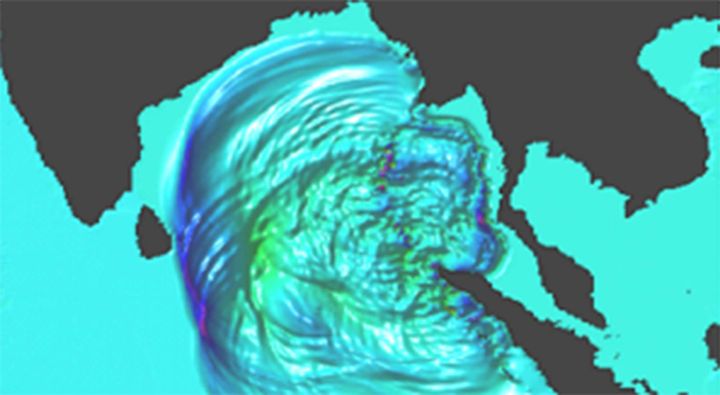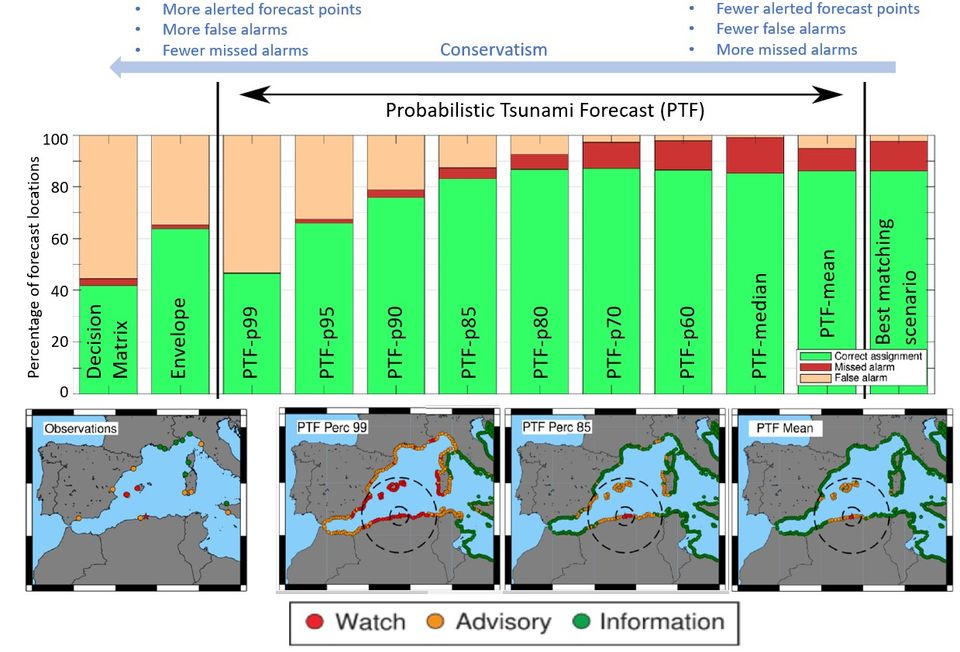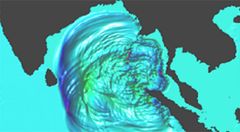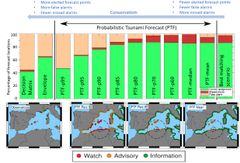New method forecasting tsunami uncertainty

Tsunamis can hit coastal societies very shortly after large earthquakes. To mitigate their impact, tsunami early warning systems can alert the coastal population and civil authorities. This may allow evacuation, and mobilization of emergency services. Immediately after the earthquake notification, the destructive potential of an associated tsunami is highly uncertain. At the start, there is much uncertainty about the exact size, the exact location, and the exact mechanism of the earthquake and generation of the tsunami. This uncertainty means that tsunami early warning systems can occasionally issue false alarms, or may even fail to warn of an actual tsunami.
Read the article published in Nature Communications here.
Current tsunami early warning systems provide single-outcome forecasts that can't account for this uncertainty. For the sake of safety, they will often overestimate the tsunami impact. This can however result in too many false warnings. The opposite could happen with a badly rigged system, with too many missed events.
Managing the risk of false alarms and missed alarms lies in the political sphere. However, decision-makers need to be informed by tsunami warning systems that accurately forecast the uncertainty. The PTF resembles modern numerical weather forecasts work by calculating multiple simulations – an ensemble – each with a slightly different starting point and slightly different model parameters. PTF works by simulating vast numbers of earthquake-tsunami scenarios, covering the full range of possible sources.
The principle is shown below. Using average forecasts, or incorporating a small part of the uncertainty, fewer false alarms are issued. However, the risk of missing events increases. Incorporating a very large uncertainty range, the missed alarms are almost eliminated. However, we thereby risk more false alarms. While the optimal solution may lie between these extremes, this selection process needs to be done through political choices by the responsible stakeholders. The PTF method provides a basis for this optimization, and links the optimal solution to the desired trade-off between false alarms, missed events, and correct warnings.

Partners:
1) Istituto Nazionale di Geofisica e Vulcanologia, Le Grazie, 2) Italy, Department of Physics “Ettore Pancini”, University of Naples, Naples, Italy, 3) German Research Centre for Geosciences (GFZ), Potsdam, Germany, 4) Norwegian Geotechnical Institute (NGI), Oslo, Norway, 5) Grupo EDANYA, Universidad de Málaga, Málaga, Spain.

Keywords
Contacts
Finn LøvholtExpert AdvisorGeohazards and Dynamics
Tel:+47 957 93 100finn.lovholt@ngi.noSteven GibbonsSenior Advisor
Tel:+47 986 13 288steven.gibbons@ngi.noImages
Links
About NGI
På sikker grunn
NGI – Norges Geotekniske Institutt – er et uavhengig, internasjonalt senter for forskning og rådgivning innen ingeniørrelaterte geofag, der vi integrerer kunnskap mellom geoteknikk, geologi og geofysikk. Vår forskning gir kunnskap som styrker norsk næringsliv til å løse noen av de viktigste utfordringene vi står overfor innenfor klima, miljø, energi og naturfarer.
Gjennom årene har vi tiltrukket oss dedikerte fagfolk og internasjonale eksperter på bruk av geomaterialer som byggegrunn og byggemateriale, skredproblematikk og forurensning av grunnen. Utvikling og anvendelse av ny teknologi står helt sentralt i vår virksomhet for å finne bærekraftige løsninger og sikre at vi bygger et samfunn på sikker grunn. Vår ekspertise og løsninger er kjent og etterspurt i store deler av verden.
NGI har hovedkontor og laboratorier i Oslo, avdelingskontor i Trondheim, forskningsstasjon for snøskred på Strynefjellet, og utenlandskontorer med geoteknisk laboratorium i Houston, Texas, USA, og i Perth, Western Australia, i tillegg til samarbeidsavtaler med veletablerte selskap og institusjoner i store deler av verden.
NGI ble formelt opprettet 1. januar 1953, underlagt Norges Teknisk-Naturvitenskapelige Forskningsråd (NTNF). I 1985 ble NGI omgjort til en selvstendig stiftelse. Driftsvirksomheten (forskning og rådgivning) ble 1. januar 2024 overført til Norges Geotekniske Institutt AS, et aksjeselskap som eies 100 % av stiftelsen NGI.
Som en av hovedpartnerne støtter NGI Ingeniører Uten Grenser (IUG) økonomisk og gjennom å bidra med ingeniørkompetanse til IUGs oppdrag for norske bistandsorganisasjoner.
Subscribe to releases from NGI
Subscribe to all the latest releases from NGI by registering your e-mail address below. You can unsubscribe at any time.
Latest releases from NGI
Global modell skal gjøre verden bedre rustet mot tsunamier17.11.2025 11:46:45 CET | Pressemelding
Da en enorm flodbølge traff kystene rundt Indiahavet andre juledag i 2004, mistet mer enn 220 000 mennesker livet. Det var en katastrofe som rystet verden og som avslørte hvor lite vi egentlig forsto om tsunamier.
NGI-forsker valgt inn i styret til European Chemicals Agency (ECHA)24.10.2025 12:15:11 CEST | Pressemelding
Forsker ved NGI - Norges Geotekniske Institutt, Hans Peter Arp, er én av verdens fremste eksperter på kjemisk forurensning. Nå skal miljøkjemikeren påvirke kjemikaliepolitikken i Europa.
NGI lanserer unikt traineeprogram innen geoteknikk30.9.2025 09:11:00 CEST | Pressemelding
Fire nyutdannede ingeniører får nå muligheten til å prøve seg på tvers av NGIs kjerneområder. Gjennom et nytt traineeprogram skal de utforske alt fra fundamentering på land til havvind og klimatilpasning.
Flere velger geoteknikk og kvinneandelen skyter i været11.9.2025 08:55:38 CEST | Pressemelding
Masterstudiet i geoteknikk ved OsloMet vokser raskt. Da studiet startet i 2022, var det fem studenter og bare menn. Denne høsten har 21 nye studenter startet, av dem åtte kvinner.
Vi kan bygge tryggere tunneler med kunstig intelligens15.8.2025 14:51:34 CEST | Pressemelding
Kunstig intelligens endrer hvordan vi bygger tunneler. Vi kan forutsi farlige forhold i berget før vi treffer dem. Det gir tryggere tunneler, lavere kostnader, mindre naturinngrep og bedre beslutninger under bakken.
In our pressroom you can read all our latest releases, find our press contacts, images, documents and other relevant information about us.
Visit our pressroom



